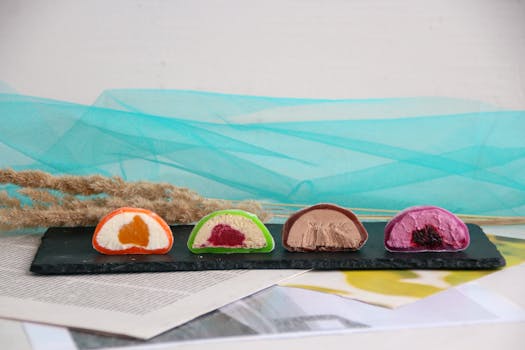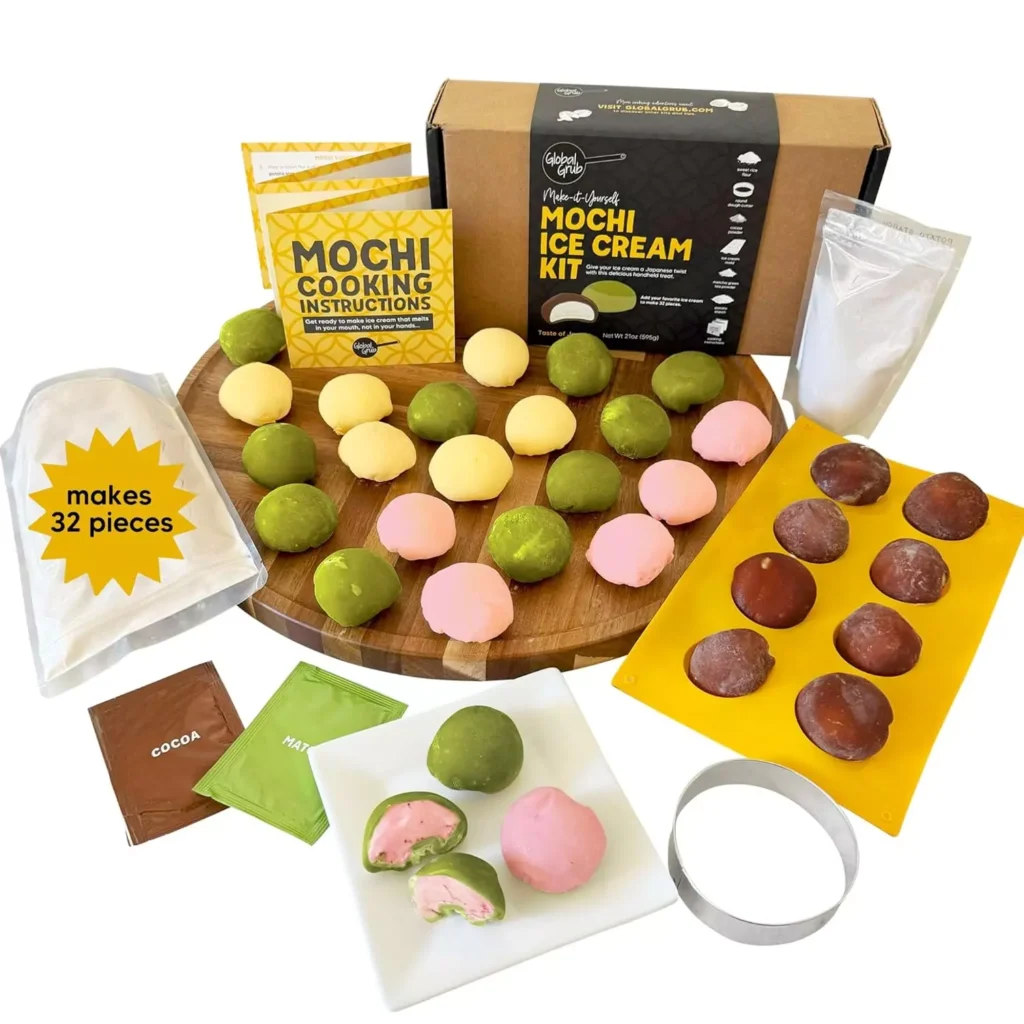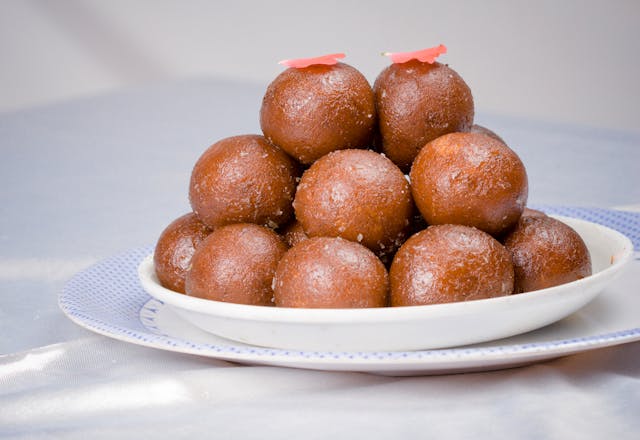![]() let’s go to JAPAN
let’s go to JAPAN![]()
Discover the delicious world of Mochi! 🌸
Mochi is a traditional Japanese sweet made from glutinous rice, known for its soft and springy texture. This dessert has captured hearts around the world with its unique flavor and versatility. But did you know that there are many varieties of mochi? From the classic Daifuku, filled with sweet red bean paste, to the refreshing Ichigo Daifuku, which includes a whole strawberry inside.
In our mochi recipe, we will teach you step by step how to prepare this delicious delicacy at home. Whether you prefer the CLASSIC AND TRADITIONAL Japanese Mochi (jump to recipe), or the Mochi ice cream. Mochi ice cream (jump to recipe) is a modern version that combines mochi dough with ice cream inside. The mochi dough envelops a scoop of ice cream, creating a delicious contrast between the smooth texture of the mochi and the creaminess of the ice cream. The most common flavors include matcha, mango, strawberry, and chocolate.
Dare to try and surprise your friends and family with these Japanese delicacies! 🍡
History of Mochi and its Meaning in Japanese Culture
One of Japan’s most iconic desserts, mochi has a rich history dating back thousands of years. Its origin dates back to the Jomon era, a prehistoric period dating back to approximately 14,000 BC. The preparation of mochi began as arduous work involving the use of glutinous rice, also known as mochigome. The process of creating mochi, known as mochitsuki, requires a combination of precision and strength, elements that are still valued in Japanese culture.
Throughout history, mochi has been a central component in various Japanese holidays and ceremonies. During the Japanese New Year, the mochitsuki ceremony unites families and communities in a collective act that symbolizes prosperity and unity. The way rice is pounded and kneaded to create mochi is considered a metaphor for cooperation and community effort. Another example of its cultural relevance is the Doll Festival (Hinamatsuri), where mochi is consumed to invoke good fortune and health for girls.
Mochi is not only a food; It also has deep symbolism in Japanese culture. It represents longevity, good fortune and health. The consumption of this delicate dessert is more than a culinary act; It is a tradition that strengthens family and community ties. In various events and rituals, mochi acts as a conduit that links the past and present, uniting generations through its flavor and the historical meaning it carries with it.
Ultimately, mochi is a tangible representation of values deeply rooted in Japanese society, which advocates harmony, prosperity and cultural continuity. Through this simple but meaningful food, traditions are perpetuated and bonds between people are reinforced.
Traditional Mochi Recipe: Step by Step to Make It at Home
Making mochi at home can be a rewarding and delicious experience. Below is a traditional recipe for making mochi from scratch. The main ingredients you will need are glutinous rice (known as mochigome) and water. Essential tools include a mochi maker or the traditional method using a mortar and pestle (usu and kine).
First, measure
2 cups of glutinous rice and rinse it several times until the water runs clear. Then, soak the rice in water for at least 6 hours or overnight. Once soaked, drain and place in a steamer for about 30-45 minutes until cooked through. You can check cooking by crushing some grains with your fingers; They should be soft and sticky.
If you use a mochi maker, follow the manufacturer’s instructions to knead the cooked rice into a smooth, elastic dough. For the traditional method, place the cooked rice in the mortar and begin pounding it rhythmically with the pestle, while another person turns and moistens the dough to prevent sticking, until the right consistency is achieved.
Then, transfer the rice dough to a damp or dusty surface with cornstarch. Divide the dough into small portions to shape it. You can choose to fill the mochi with anko (sweet red bean paste) or matcha cream, carefully wrapping the filling inside the rice dough.
A helpful tip for getting the perfect texture is to keep your hands and work surface well moistened or dusted with starch. This will prevent the mochi from sticking. To keep the mochi fresh, wrap it tightly in plastic wrap and store it in the refrigerator. You can warm it slightly in the microwave before consuming it to restore its softness.
The Best Places to Enjoy Mochi in Japan
Japan is a country with a deep tradition in making and tasting mochi. This delicious sweet glutinous rice can be found in various regions, each providing its own essence and special touch. For those who wish to explore mochi in its most authentic and exquisite form, here is a guide to some of the most notable establishments to enjoy this delicacy in Japan.
In Kyoto, a city known for its rich cultural heritage, there are several shops specializing in mochi that come highly recommended. Tsuruya Yoshinobu, founded in 1803, is famous for its elaborate and artistic wagashi, including mochi. Additionally, in the heart of Kyoto is Demachi Futaba, famous for its tasty mame-mochi, which attracts locals and tourists alike.
Tokyo, Japan’s vibrant capital, also offers plenty of options for mochi lovers. Nakatanidou, a shop with over a hundred years of history, is known for its mochi rice tamales freshly made in Asakusa. In the Ginza area, Mochikichi stands out for its elegant presentation and variety of modern mochi, perfect for those looking for a more contemporary experience.
In other regions of Japan, you can find real gems for tasting mochi. In Nara, Chikaramochiya offers fresh mochi made using traditional preparation methods. For a unique experience, it’s worth visiting Hiroshima and trying Kyo Hayashiya’s mochis, which specialize in innovative variations on this classic sweet.
In addition to specialty shops, several locations in Japan offer enriching cultural experiences. Places like the Tsubaki Grand Shrine in Mie allow visitors to participate in mochitsuki, a traditional mochi-making ceremony where glutinous rice is beaten with wooden mallets. This activity not only provides a deep understanding of the patience and precision required to make mochi, but it is also a fun way to connect with local customs.
For those interested in the history and craftsmanship of mochi, visiting these establishments and participating in these cultural experiences offers a complete insight into the wonder that is mochi in Japan. From the historic streets of Kyoto to the modernity of Tokyo, the journey to discover mochi is an unforgettable experience.
Simple recipe to make Mochi ice cream at home
Ingredients:
- 1 cup of glutinous rice flour (mochiko)
- 3/4 cup sugar
- 1 cup of water
- Ice cream of your favorite flavor (previously frozen in small balls)
- Cornstarch (to sprinkle)
Instructions:
- Prepare the ice cream:
- Form small ice cream balls using an ice cream scoop or a regular spoon.
- Place the ice cream balls on a tray lined with wax paper and freeze until completely firm.
- Prepare the mochi dough:
- In a large bowl, mix the glutinous rice flour and sugar.
- Add the water little by little while mixing until you obtain a homogeneous mass.
- Cover the bowl with microwave-safe plastic wrap.
- Cook the dough:
- Microwave at maximum power for 3 minutes.
- Take out the bowl and stir the dough well. Cover again and cook for 1-2 more minutes until the dough is translucent and sticky.
- Form the mochi:
- Sprinkle a clean surface with cornstarch.
- Pour the cooked dough onto the surface and sprinkle more cornstarch on top to prevent it from sticking.
- With your hands also sprinkled with cornstarch, roll out the dough until it is approximately 1 cm thick.
- Wrap the ice cream:
- Cut the dough into small circles, large enough to wrap the ice cream balls.
- Place a scoop of ice cream in the center of each circle of dough and wrap it carefully, sealing the edges well.
- Place the mochi ice cream on a tray and freeze them again until they are firm.
- Serve:
- Let the mochi ice cream sit at room temperature for a few minutes before serving so that the dough softens a little.
- Enjoy your homemade mochi ice cream!
I hope you enjoy making and eating these delicious ice cream mochi. 🍨
*Some prices may have changed since the last review.
“Some links on this page are affiliate links. And they could bring a financial benefit to Heavenlyflavor.site at no additional cost to you.”







